These herbs are a natural way to support your health and well-being.
We’ve got seven herbs to grow now! Whether you want to start growing herbs indoors or outdoors we have tips for you on which herbs are best suited for this time of year. So, let’s get going and create our own herbal garden!

The benefits of using natural herbal remedies over store-bought ones are numerous. Natural herbs provide a wide range of health benefits, such as reducing inflammation, boosting immunity, improving digestion and promoting sound sleep.
Herbs also contain antioxidants that can help cleanse wounds and protect against infection.
Furthermore, growing your own herbs allows you to experience the maximum flavor intensity when harvesting them for use in cooking or other applications such as teas or tinctures/infusions.
Additionally, growing your own herbs is more cost effective than buying them from a store. Plus, it’s fun! Get creative with different combinations of plants and herbs to find the perfect remedy that suits your needs.
Herbs to grow now:
→ General instructions for all 7 herbs to grow now:
1. Select a sunny spot for your herbs and prepare the soil, adding organic matter such as compost or manure.
Do your herb plants a favor and choose their sunbathing hours wisely. The age-old question of whether morning or afternoon sun is best for growing herbs may not have a clear-cut answer, but one thing is for sure- herbs love the sun!
.In fact, sunlight is like liquid gold to these little sprouts, so it’s crucial to give them the right amount at the right time.
.When deciding on a sunny spot for your herb garden, keep in mind that herbs need at least six hours of sunlight per day. While morning sun may be cooler and gentler, afternoon sun can be intense and scorching.
.If you live in a particularly hot area, it may be best to give your herbs a break during the hottest hours of the day. With a bit of experimentation and observation, you’ll soon discover which sunbathing schedule works best for each of your little herb companions.
2. Sow seeds directly in the ground or container, or start with seedlings from a nursery.
Growing herbs is one of the most satisfying and rewarding experiences for any green thumb out there. But before you can start your own herb garden, it’s important to be wise when selecting your seeds or seedlings. Because nobody wants to end up with a sad little plant that can’t survive more than a few days, right?
.So, what should you look for when buying herb seeds or seedlings?
.First, pay attention to the quality of the seeds or the health of the seedlings or plants from your local nursery. Are they strong, fresh, and vibrant?
.Second, consider the type of herb you want to grow. Do you prefer something that’s easy to care for or something that’s a little more adventurous?
.There are so many herbs to grow, but choosing the right one for your garden will ensure that you will have a fruitful and enjoyable experience.
3. Water regularly but do not over water; too much moisture can lead to root rot and fungal diseases in some cases.
Have you ever tried to grow herbs but ended up drowning them in water or parching them to death? It can be frustrating to figure out the right balance of when and how much to water your precious plant babies.
.To avoid the guessing game, the best way to gauge when to water your herbs is to stick your finger into the soil about an inch deep. If it feels dry, it’s time to water.
.But how much water should you give them?
.A good rule of thumb is to water until you see water draining out of the drainage holes. Whether your herbs are basking in the sun on your windowsill or enjoying the fresh air outdoors, following these tips will ensure happy and healthy herbs to grow now and for seasons to come.
4. When planting outdoors, mulch around your plants to protect them from extreme weather and temperature fluctuations, as well as keep weeds at bay.
Mulching is the method of choice for many gardeners with outdoor plants. But what exactly is the best material to use? Some swear by straw, others by shredded leaves, and still others by pine needles.
.And what about thickness? Should it be a light dusting or a thick blanket? Thankfully, the answer isn’t as elusive as a rare herb plant. The key is to use whatever is readily available and natural in your area, and aim for a depth of 2-4 inches.
.So go ahead and mulch around your herb plants with pride, knowing that they’ll be cozy and protected.
5. Trim back any flowers that appear on the plant to promote new leaf growth instead of flower production.
As spring blooms into summer, the herbs to grow now are aplenty, but what if you’re interested in leafy growth instead of attractive petals?
.Whether you’re tending to your herbs indoors or outside, there’s a simple solution to promote leaf production over flowering: snip away!
.Trim back any flowers that appear on your herb plant to redirect its energy into growing large, lush leaves, perfect for seasoning up your summer dishes.
.We all agree that flowers are pretty, but who needs them when you can have a bounty of savory herbs at your fingertips? So go ahead, give those herbs a haircut, and watch them thrive.
6. Prune back stems after flowering is finished – this will prevent leggy growth caused by excessive branching outwards rather than upwardly towards the sun’s rays.
Nobody wants leggy growth. Whether you’re growing your herbs indoors or out, the same principles apply.
.Start by identifying any dead or diseased stems and removing them completely. Then, take a step back and assess the overall shape of your plant. Are there any stems that are crossing or growing in the wrong direction? Go ahead and snip those away as well.
.Lastly, take a deep breath and boldly cut back any stems that have already flowered. This may feel counterintuitive, but believe me–it’s the key to ensuring your plant grows bushy and full.
7. Harvest throughout the growing season when leaves are young and tender for maximum flavor intensity; use fresh or dry them for future use in cooking or other applications such as teas, or tinctures, infusions, and the like.
As you tend to your herb garden, you may find yourself pondering the eternal question: to dry or not to dry?
.When it comes to making medicinals and teas from your freshly-plucked herbs, both fresh and dried options have their perks. Fresh herbs provide a burst of flavor and aroma that can elevate any dish or drink, while their dried counterparts offer a longer shelf life and concentrated flavor profile.
.So, how should you go about drying your herbs? You could hang them upside down, spread them out on a screen, or even use a dehydrator. Whichever method you choose, be sure to handle your herbs with care – after all, you’ve spent all season cultivating these little wonders!
→ For growing herbs indoors
Pot up containers with good-quality potting mix and plant seeds or seedling as indicated on package or care instructions.
Bringing the outdoors inside… Sure, there’s nothing quite like the feel of soil between your fingers and the sunshine on your skin, but let’s face it – not everyone has access to a lush green backyard.
.Fortunately, growing herbs indoors allows you to enjoy fresh, aromatic herbs year-round. Whether you’re a seasoned pro or a newbie to the herb-growing game, there are plenty of options to choose from.
.Of course, indoor herb gardens require a bit of different planting and care techniques than their outdoor counterparts, but with a little patience and practice, you can have a thriving mini-garden in no time. Spice things up (literally) inside with these easy-to-grow herbs!
→ 7 Herbs to Grow Now
.

Oregano
1. Growing Oregano
With your freshly grown oregano, you can make teas, tinctures/infusions, as well as use them in cooking or baking to add flavor.
Oregano is a great way to not only give food some extra flavor but also boost immunity!
Get potted oregano online here, or an assortment of seeds here.
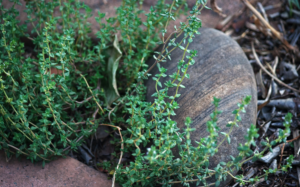
Thyme
2. Growing Thyme
Thyme has many medicinal properties, including antiseptic, antiviral, anti-fungal, and expectorant qualities.
It’s also a great way to add flavor to your food! Use it in teas, tinctures/infusions or cooking.
Potted Thyme is available here, or an assortment of seeds here.
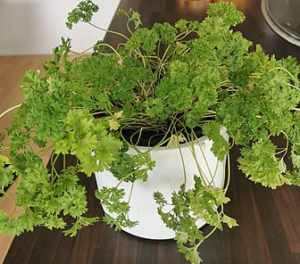
Parsley: Netha Hussain, CC BY-SA 4.0, via Wikimedia Commons (image cropped)
3. Growing Parsley
Parsley is a great addition to any garden, not only because of its flavor but also because it’s full of vitamins, minerals and antioxidants.
Enjoy it as a garnish on dishes or use in teas, tinctures/infusions, soups and salads! With all these herbs at hand, you can create delicious recipes that are sure to please the whole family.
So why wait? Start growing herbs now and enjoy the amazing health benefits they have to offer!
Get the plant or an assortment of seeds here.
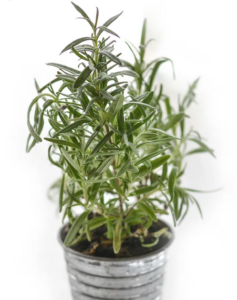
Rosemary
4. Growing Rosemary
Rosemary‘s intense aroma and taste make it a favorite among many cooks. But did you know that rosemary also contains numerous health benefits? It’s loaded with antioxidants that can help reduce inflammation and boost your immunity. Rosemary also has antiseptic, antiviral, anti-fungal, and expectorant qualities.
With parsley and rosemary at hand, you have the perfect ingredients for making herbal remedies that can help with ailments such as sore throats or colds. Get a variety pack of seeds here or the plant.
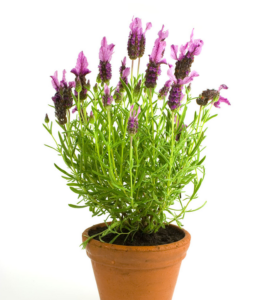
Lavender
5. Growing Lavender
Lavender is a versatile herb that can be used in many ways!
Not only does it have a calming effect on the body, but it also contains antioxidants and antiseptic properties to help cleanse wounds and protect against infection.
Lavender is also known to boost immunity, reduce inflammation, improve digestion, and promote sound sleep.
You can buy Lavender seeds here, or a one gallon, one foot tall, potted plant (at Amazon) here.
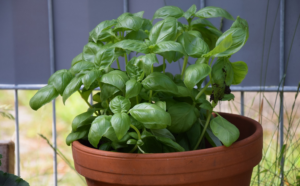
Basil
6. Growing Basil
Basil is a versatile herb that offers a variety of benefits when used medicinally, both indoors and out.
It has anti-inflammatory, antioxidant, and antiseptic properties, which make it an ideal remedy for treating digestive issues, skin irritations and infections, as well as colds and flu. Get a variety pack of seeds here or plant.

NahidHossain, CC BY-SA 4.0, via Wikimedia Commons (image cropped)
7. Growing Mint
Mint is known for its medicinal properties, as it can be used to soothe digestive issues, help with respiratory problems, and reduce headaches.
Did you know that mint leaves contain high levels of Vitamin A, B-complex vitamins, and minerals, such as calcium, iron, and magnesium. Now that’s healthy!
Get the plant or seeds online! For seeds look here, or plants here.
So why not get started with these 7 herbs to grow now?
May is the ideal month to start growing these herbs – both indoors and outdoors – so why not get started today?
With just a bit of effort, you can cultivate an amazing herb garden that will provide delicious ingredients for cooking as well as natural healing remedies. Get creative and grow your own herbal remedies now and reap the rewards of these amazing herbs have to offer!
Enjoy herbs in cooking, as colorful additions as toppers, or use them in teas, tinctures/infusions, soups and salads!
Now you’re ready to experience the delicious flavor of fresh herbs grown right from your own garden – indoors or out. May is a great time to start for maximum flavor intensity!
Don’t have a green thumb? No worries, you can start growing these easy-to-care-for herbs indoors in just a few weeks time.
In case you are interested, my absolute favorite herb to grow indoors is Basil! Once you have had it fresh, you’ll never go back to the spice rack for it!
